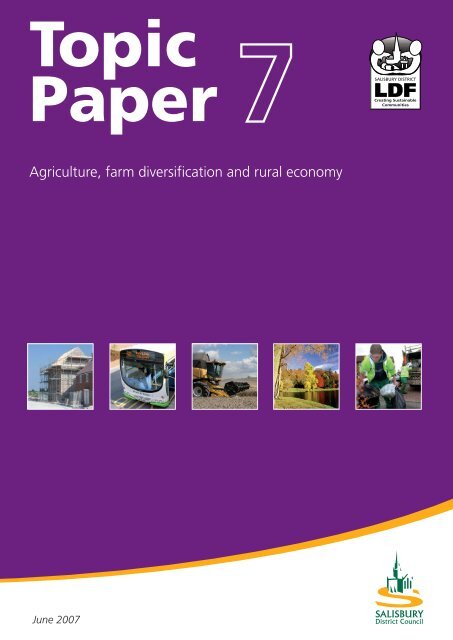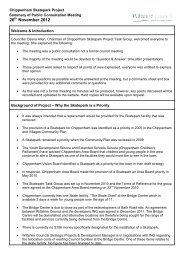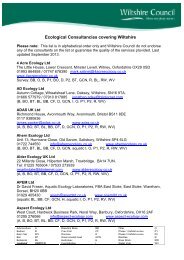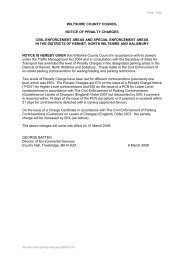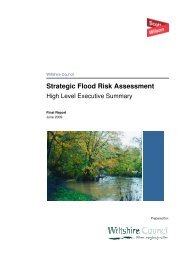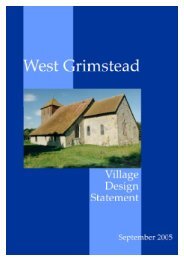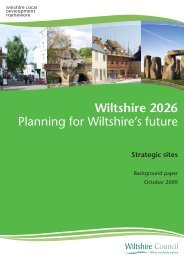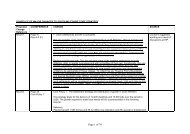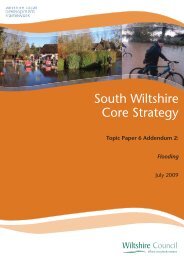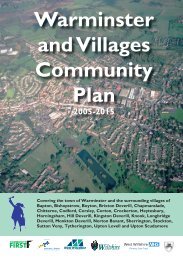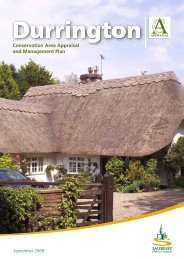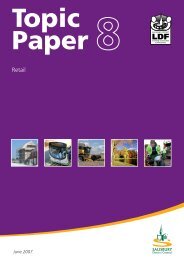Agriculture, farm diversification and rural economy - Wiltshire Council
Agriculture, farm diversification and rural economy - Wiltshire Council
Agriculture, farm diversification and rural economy - Wiltshire Council
You also want an ePaper? Increase the reach of your titles
YUMPU automatically turns print PDFs into web optimized ePapers that Google loves.
Topic7 PaperSALISBURY DISTRICTLDFCreating SustainableCommunities<strong>Agriculture</strong>, <strong>farm</strong> <strong>diversification</strong> <strong>and</strong> <strong>rural</strong> <strong>economy</strong>June 2007
INTRODUCTIONSalisbury district is a predominantly <strong>rural</strong> district <strong>and</strong> therefore the prosperity of the <strong>rural</strong> areais important.Changes in agriculture over recent decades have resulted in a decline in <strong>farm</strong>-related jobs,<strong>and</strong> an increase in the stock of l<strong>and</strong> <strong>and</strong> buildings that are no longer required for agriculturalpurposes. Since 2003/04 the average <strong>farm</strong> income has fallen from £24,700 to £17,500 in2005/06 (source defra, http://statistics.defra.gov.uk/esg/quick/agri.asp, accessed 26/03/2007)this is a trend that has been occurring for several years. The structure <strong>and</strong> type of <strong>farm</strong> hasalso changed. At the same time there are increasing environmental dem<strong>and</strong>s following onfrom legislative <strong>and</strong> policy commitments <strong>and</strong> public expectation, which will potentially makethe role of <strong>farm</strong>ers <strong>and</strong> growers more challenging <strong>and</strong> complex. Simultaneously, the recentCommon Agricultural Policy reform requires <strong>farm</strong>ers to become more self reliant <strong>and</strong> marketfocused rather than subsidy based upon <strong>farm</strong> production. It has therefore becomeincreasingly important for <strong>farm</strong>ers to be able to diversify their economic base in order tosupplement their incomes <strong>and</strong> ensure the continued survival of <strong>farm</strong>s <strong>and</strong> l<strong>and</strong> management.1. ISSUES FACING SALISBURY DISTRICTSince 1990 within Salisbury district both the number of full time <strong>farm</strong>ers <strong>and</strong> the number ofholdings that have been <strong>farm</strong>ed have reduced in number, conversely the number of part time<strong>farm</strong>ers <strong>and</strong> holdings <strong>farm</strong>ed has increased 1 .Number of <strong>farm</strong>ers <strong>and</strong> holdings <strong>farm</strong>ed in Salisbury District1000928 928800600400552 555598472446332 31443349165920001990 1995 2000 2005YearSource: DefraFull Time (holdings)Agricultural CensusFull Time (number) Part Time (holdings) Part Time (number)At the same time the number of small <strong>farm</strong>s <strong>and</strong> the very largest has increased whilst thoseof medium size have declined. However it should be noted that the data from <strong>and</strong> including2000 includes minor holdings <strong>and</strong> therefore it would be expected that the number of small<strong>farm</strong>s would increase.1 Defra Agricultural Census: data relates to main <strong>and</strong> minor holdings – from <strong>and</strong> including 2000, Data relates tomain holdings only – pre 2000.
Size of <strong>farm</strong>s (number)450400
scheme replaces the previous Countryside Stewardship Schemes <strong>and</strong> EnvironmentallySensitive Areas.Although the schemes represent a stream of income that is available to <strong>farm</strong>ers, the recentCommon Agricultural Policy reform simultaneously, requires <strong>farm</strong>ers to become more selfreliant <strong>and</strong> market focused rather than subsidy based upon <strong>farm</strong> production. There is alsocontinuing uncertainty surrounding the future direction of the European Union CommonAgricultural Policy that altogether trigger an additional need to support the <strong>rural</strong> <strong>and</strong> <strong>farm</strong>ing<strong>economy</strong>.Salisbury is also in a fortunate position to have a flat racing horse racing facility locatedbetween Salisbury <strong>and</strong> Wilton as well as holding many point to point races on Larkhill(Salisbury Plain). This can assist the <strong>rural</strong> <strong>economy</strong>, <strong>and</strong> the needs of horse training,breeding <strong>and</strong> livery businesses together with commercial horse riding stables, should beencouraged as part of <strong>farm</strong> <strong>diversification</strong> enterprises. However these need to be achievedwhilst maintaining environmental quality <strong>and</strong> countryside character. Please also see topicpaper 9 – Employment l<strong>and</strong>, the <strong>economy</strong>, agriculture <strong>and</strong> <strong>farm</strong> <strong>diversification</strong>.
2. THE NATIONAL AND REGIONAL POLICY FRAMEWORKNational GuidancePlanning Policy Statement 7 (PPS7) Sustainable Development in Rural AreasIdentifies the following issues that should be addressed:• Need to develop competitive, diverse <strong>and</strong> thriving <strong>rural</strong> enterprise that provides a rangeof jobs <strong>and</strong> underpins strong economies<strong>Agriculture</strong> <strong>and</strong> <strong>farm</strong>ing• Need to promote sustainable, diverse <strong>and</strong> adaptable agriculture sectors where <strong>farm</strong>ingachieves high environmental st<strong>and</strong>ards, minimising impact on natural resources, <strong>and</strong>manages valued l<strong>and</strong>scapes <strong>and</strong> biodiversity, contributes both directly <strong>and</strong> indirectly to<strong>rural</strong> economic diversity; is itself competitive <strong>and</strong> profitable, <strong>and</strong> provides high qualityproduces that the public wants.• Recognise the important <strong>and</strong> varied roles of agriculture, including the maintenance <strong>and</strong>management of the countryside <strong>and</strong> most of our valued l<strong>and</strong>scapes. Supportdevelopment proposals that will enable <strong>farm</strong>ing <strong>and</strong> <strong>farm</strong>ers to:‣ Become more competitive, sustainable <strong>and</strong> environmentally friendly‣ Adapt to new <strong>and</strong> changing markets‣ Comply with changing legislation <strong>and</strong> associated guidance‣ Diversify into new agricultural opportunities (e.g. renewable energy crops) or‣ Broaden their operations to ‘add value’ to their primary produce• Recognise that <strong>diversification</strong> into non-agricultural activities is vital to the continuingviability of many <strong>farm</strong> enterprises:‣ Set out criteria to be applied to planning applications for <strong>farm</strong> <strong>diversification</strong>projects‣ Be supportive of well-conceived <strong>farm</strong> <strong>diversification</strong> schemes for businesspurposes that contribute to sustainable development objectives <strong>and</strong> help tosustain the agricultural enterprise, <strong>and</strong> are consistent in their scale <strong>and</strong> their <strong>rural</strong>location.• Encourage the re-use or replacement to of existing buildings where feasible <strong>and</strong> haveregard to the amenity of nearby residents or other <strong>rural</strong> businesses that may be affectedby new types of on-<strong>farm</strong> development.• PPS7 suggests that LPAs should provide policies to protect specific areas of the best <strong>and</strong>most versatile agricultural l<strong>and</strong> from speculative developmentForestry• Manage existing woods <strong>and</strong> forests sustainably• Encourage the continued expansion of woodl<strong>and</strong> areas to provide more benefits forsociety <strong>and</strong> the environment• The planning system is the principal means for regulating the rate at which l<strong>and</strong> istransferred from woodl<strong>and</strong>s to other <strong>rural</strong> <strong>and</strong> urban uses.Commercial equestrian activity• Recognise that horse riding <strong>and</strong> other equestrian activities are popular forms ofrecreation in the countryside that can fit in well with <strong>farm</strong>ing activities <strong>and</strong> help to diversify<strong>rural</strong> economies.• Horse training <strong>and</strong> breeding businesses play an important economic role. Local planningauthorities should set out policies for supporting equine enterprises that maintainenvironmental quality <strong>and</strong> countryside character.• These policies should provide for a range of suitably located recreational <strong>and</strong> leisurefacilities <strong>and</strong>, where appropriate, for the needs of training <strong>and</strong> breeding businesses.• They should also facilitate the re-use of <strong>farm</strong> buildings for small-scale horse enterprisesthat provide a useful form of <strong>farm</strong> <strong>diversification</strong>.http://www.communities.gov.uk/pub/825/PlanningPolicyStatement7SustainableDevelopmentinRuralAreas_id1143825.pdf
Water Resources for the Future (2001) Environment Agency<strong>Agriculture</strong> must focus on using available water to best effect.http://www.environment-agency.gov.uk/subjects/waterres/137651/?version=1&lang=_eEngl<strong>and</strong> Forestry Strategy (1999) has two main aims that are the sustainable managementof existing woods <strong>and</strong> forests; <strong>and</strong> a continued steady expansion of woodl<strong>and</strong> area toprovide more benefits for society <strong>and</strong> the environment.http://www.forestry.gov.uk/efsRegional GuidanceThe Draft Regional Spatial Strategy for the South West 2006-2026Businesses in <strong>rural</strong> areas now <strong>and</strong> in the foreseeable future are likely to have littleconnection with the l<strong>and</strong>-based industries but should be supported where they secure jobsfor local people <strong>and</strong> improve the viability of <strong>rural</strong> communities. The Rural DevelopmentRegulation is likely to encourage greater <strong>diversification</strong> away from agricultural activity, <strong>and</strong> anincreased desire on the part of <strong>farm</strong>ers to diversify their capital assets. Encouragementshould be had for the development of small businesses in the ‘market towns’ <strong>and</strong> smallersettlements throughout the region. Small businesses in <strong>rural</strong> areas should be based insustainable <strong>and</strong> accessible locations to avoid pressures on local environments <strong>and</strong> roads.The draft RSS recognises that the region is characterised by <strong>farm</strong>l<strong>and</strong>, woodl<strong>and</strong> <strong>and</strong>forestry alongside being a place to live, work <strong>and</strong> enjoy <strong>and</strong> identifies that as changes toagricultural policy <strong>and</strong> industry takes place less l<strong>and</strong> is likely to be used primarily for foodproduction. Therefore the RSS identifies that local authorities should promote an integratedapproach to l<strong>and</strong> management by developing area=specific packages that achieve multiplebenefits, reinforce <strong>and</strong> enhance the specific natural <strong>and</strong> cultural features or local areas.The RSS further identifies that the Best <strong>and</strong> Most Versatile Agricultural l<strong>and</strong> should beprotected for food production, as they are the most flexible in terms of food production.
Best <strong>and</strong> Most VersatileAgricultural L<strong>and</strong>With respect to commercial forestry the RSS identifies that the wider economic use ofwoodl<strong>and</strong>s <strong>and</strong> forest should be promoted for example with respect to wood fuelhttp://www.southwest-ra.gov.uk/nqcontent.cfm?a_id=836Regional Woodl<strong>and</strong> <strong>and</strong> Forestry FrameworkOur woods <strong>and</strong> forests make a significant contribution to the region’s <strong>economy</strong>, of over£500m per annum forestry should directly contribute to renewable energy <strong>and</strong> increase thecontribution of woodfuel to renewable energy supplies in the South West, measured byinstalled capacity.http://www.forestry.gov.uk/sw-rff
3. LINKING IT TOGETHER – WHAT DO OTHER LOCAL STRATEGIES SAY?South West Biodiversity Implementation PlanRequires the provision of enhanced conditions for the maintenance <strong>and</strong> return of biodiversityto arable l<strong>and</strong> <strong>and</strong> improved grassl<strong>and</strong>.http://www.swbiodiversity.org.uk/Regional/swbippage.htmThe Delivery Plan for Sustainable Farming <strong>and</strong> Food industry in the South West 2004Relevant objectives from the delivery plan are to;• Reduce <strong>rural</strong> inequalities <strong>and</strong> supporting viable livelihoods, particularly by improvingaccess to relevant schemes <strong>and</strong> initiatives;• Increased viability of local <strong>and</strong> regional food <strong>and</strong> <strong>farm</strong>ing businesses.• Create more opportunities for <strong>farm</strong>ers to supplement their incomes from agri-environmentschemes geared to the region’s needs <strong>and</strong> opportunities.• Encourage <strong>farm</strong>ers <strong>and</strong> food companies to develop renewable energy on their l<strong>and</strong> or intheir buildings.• Encourage District <strong>Council</strong>s to encourage renewable energy developments• Identify localised agricultural <strong>and</strong> food waste-to-energy solutions, particularly centralisedanaerobic digestion.• Alternative uses to be found for <strong>farm</strong> buildings, such as leisure, offices <strong>and</strong> workshops.• Farmers to diversify into alternative crops, <strong>and</strong> tourism & leisure activities• Maintaining our countryside industries: <strong>farm</strong>ing, fishing, forestryhttp://www.gos.gov.uk/gosw/env<strong>rural</strong>/<strong>farm</strong><strong>and</strong>food/
5. LEARNING FROM EXPERIENCEa) How do our existing policies perform?The following policies from within the existing Local Plan address a wide rang of issuesrelated to community <strong>and</strong> cultural activities. While many have proved to be effective, theywill need to be thoroughly reviewed as part of the LDF process.Policy Purpose CommentC19 Protects the best <strong>and</strong> mostversatile agricultural l<strong>and</strong>A similar policy needs to be carried forward tobe in conformity with PPS7 <strong>and</strong> the draft RSSC20 Allows development which is A similar policy should be carried through.essential to the needs ofagriculture, forestry <strong>and</strong>horticulture subject to criteriawhich include thedevelopment would beinappropriate in an urbanarea, it is directly related to aholding <strong>and</strong> measures areincluded to prevent pollution,over-abstraction <strong>and</strong>degradation of water courses<strong>and</strong> groundwater sourcesC21 Permits <strong>farm</strong> <strong>diversification</strong> A similar policy should be carried through that ismore positive.The following policies will be reviewed under other topic paper areas:G3 (water environment) (Topic Paper 12)E19 (employment sites in the countryside) (Topic Paper 9)E21 (new employment sites in the countryside) (Topic Paper 9)E20 (change of use to employment use in countryside) (Topic Paper 9)C2 (Limited development to that which would benefit the local <strong>economy</strong> or the environment)(Topic Paper 9)C4 (Prevents development that would harm the AONB) – (Topic Paper 5)C9 (prevents the loss of woodl<strong>and</strong>, encourages planting of indigenous species) (Topic Paper5)C22 (promotes change of use of buildings to employment first) (Topic Paper 9)b) What are others doing to tackle similar problems?A short benchmarking exercise was undertaken to underst<strong>and</strong> how some other localauthorities have dealt with retailing within their Core Strategies. This was achieved througha r<strong>and</strong>om internet search.Maldon - have suggested a range of options from continuing their current policies ofrestricting <strong>diversification</strong> to encouraging <strong>rural</strong> <strong>farm</strong> scale business clusters to allow clusterssubject to criteria, or the ability to suggest another option. This appears in Genericdevelopment issues <strong>and</strong> options. Within the same paper the first section is ‘Strategic Issues<strong>and</strong> Options’ which is preceded by a spatial portrait of the area. This section deals withissues such as restricting out-commuting, increasing skills of the workforce, increasingaccess to the wider community, making public transport more attractive, <strong>and</strong> establishing theretail hierarchy.Suffolk coastal - have proposed a ‘preferred’ option <strong>and</strong> then proposed other alternativeoptions. They have further asked if there are any further options that should be pursued.
East Cambridgeshire - have put together a three page summary for economic developmentwhich explains the background to the district <strong>and</strong> the policy requirements, It then has threepolicy options which are associated with employment sites <strong>and</strong> whether they should besustained, the protection of employment sites <strong>and</strong> the degree that <strong>farm</strong>ers should be able todiversify to.Bradford metropolitan - have used the Topic paper approach, this goes through theeconomic trends, the policy guidance, the employment l<strong>and</strong> supply, the location ofemployment, protection of existing employment sites, <strong>and</strong> <strong>rural</strong> <strong>diversification</strong>. There arethen questions throughout the topic paper asking consultees to comment…..
6. KEY ISSUES AND SPATIAL PATTERNSPPS7 encourages planning authorities to support a wide range of economic activity in <strong>rural</strong>areas at an appropriate scale in sustainable locations through identifying suitable sites forfuture economic development <strong>and</strong> through identifying criteria by which economicdevelopment would be permitted together with extensions to premises.PPS7 also identifies the need to promote a competitive, sustainable, diverse <strong>and</strong> adaptableagricultural sector which achieves high environmental st<strong>and</strong>ards, minimising impact onnatural resources, managers valued l<strong>and</strong>scapes <strong>and</strong> biodiversity <strong>and</strong> contributes directly <strong>and</strong>indirectly to <strong>rural</strong> economic diversity. The best <strong>and</strong> most versatile agricultural l<strong>and</strong> shouldalso be protected. PPS7 also encourages both <strong>farm</strong> <strong>and</strong> non-<strong>farm</strong> <strong>diversification</strong> for <strong>farm</strong>ers.Commercial equestrian activity is also encouraged, together with the sustainablemanagement of existing woods <strong>and</strong> forestry <strong>and</strong> the re-use or replacement of existingbuildings.The RSS further encourages the development of small businesses in the smaller settlements<strong>and</strong> in <strong>rural</strong> areas in sustainable locations that meet organic growth <strong>and</strong> <strong>rural</strong> investment.The RSS also recognises that changes to the Common Agricultural Policy (CAP) willencourage greater <strong>diversification</strong> away from agricultural activities.The Structure plan seeks to provide scope to existing employers moving into <strong>Wiltshire</strong> tocreate sufficient high quality jobs for the growing population. A strong <strong>and</strong> diverse <strong>rural</strong><strong>economy</strong> should also be maintained.Salisbury district is pre-dominantly <strong>rural</strong>, <strong>and</strong> a large proportion of the population lives <strong>and</strong>works in the <strong>rural</strong> parts of the district. Maintaining an employment base within the <strong>rural</strong> areais important because the <strong>farm</strong>ing industry is changing <strong>and</strong> because we need to reduce theamount of <strong>rural</strong> to urban community to work. At the same time the best <strong>and</strong> most versatileagricultural l<strong>and</strong> should be protected to ensure it is available for food production. The councilwill ensure this is achieved.By supporting existing <strong>and</strong> creating small-scale businesses in the countryside, people wholive in the countryside would have a greater range of opportunities to work near to home <strong>and</strong>should result in a more competitive, thriving, diverse <strong>rural</strong> enterprises. A fine balance needsto be struck between reducing <strong>rural</strong> to urban commuting, whilst also not encouraging theurban population to commute to new employers in the countryside. For this reason, the sizeof businesses in the countryside generally needs to be small scale.In some situations, it may be appropriate to allow <strong>farm</strong>ers to diversify by developing smallscale businesses on their l<strong>and</strong> that are either related to <strong>farm</strong>ing or unrelated to agriculturesuch as holiday cottages or small scale offices <strong>and</strong> the conversion of redundant buildings tocommercial re-use. Local food producers should also be supported.Rural businesses as well as urban ones need to become more environmentally friendly.Therefore <strong>farm</strong>ers in the process of food production should ensure that water is used to besteffect. Farmers should also be encouraged to develop renewable energy on their l<strong>and</strong>whether this is for example bio mass production or food to waste energy solutions, althoughthis could have a l<strong>and</strong>scape implication.Being predominantly <strong>rural</strong> equestrian activity also can make an important contribution to thelocal <strong>economy</strong>, especially with the presence of Salisbury Racecourse in the district. Supportshould therefore be provided towards the needs of horse training, breeding <strong>and</strong> liverybusinesses <strong>and</strong> other commercial equine enterprises in the countryside.Should the council promote positively <strong>farm</strong> <strong>diversification</strong> to enable <strong>farm</strong>ers to diversity toincrease their incomes, should this be related to their <strong>farm</strong>ing business or unrelated?
Should <strong>farm</strong>ers be able to re-use redundant <strong>farm</strong> buildings for commercial enterprise / <strong>farm</strong><strong>diversification</strong> schemes.Should small-scale business development in the countryside be supported?Should the small- scale business development in <strong>rural</strong> areas be focussed in or near localservice centres?Should the council encourage <strong>farm</strong>ers to develop renewable energy on their l<strong>and</strong>?Should the importance that commercial equestrian activity makes to the <strong>rural</strong> <strong>economy</strong> berecognised? Which aspects need to be supported?Should local food production companies also be supported?Should <strong>farm</strong>ers be encouraged to use water to best effect?Forestry <strong>and</strong> Woodl<strong>and</strong>PPS7, the Engl<strong>and</strong> Forestry Strategy <strong>and</strong> the Regional Woodl<strong>and</strong> <strong>and</strong> Forestry Frameworktry to ensure that existing woods <strong>and</strong> forests are managed sustainably. PPS7 <strong>and</strong> theEngl<strong>and</strong> Forestry Strategy would like to see the expansion of forests in order for benefits forsociety <strong>and</strong> the environment to be provided. At the regional level the RSS <strong>and</strong> the RegionalWoodl<strong>and</strong> <strong>and</strong> Forestry Framework encourages a wider economic use for woodl<strong>and</strong>s.
7. OPTIONSBased on the issues identified <strong>and</strong> the policy framework in place, this section draws together options. The tables below represent a long list of options whichmay site more comfortably within either the core strategy or a more specific DPD. The impacts identified are compared against the sustainability criteria in theAppendix of this topic paper<strong>Agriculture</strong> <strong>and</strong> equestrianOptionNo.Nature of the Option Key Drivers Positive Impacts Negative Impacts Viability ofproceeding with theoption?1 Should the council promotepositively <strong>farm</strong> <strong>diversification</strong> toenable <strong>farm</strong>ers to diversity toincrease their incomes, should thisbe related to their <strong>farm</strong>ingbusiness or unrelated.2 Should small scale businessdevelopment in the countryside besupported?3 Protect the best <strong>and</strong> most versatileagricultural l<strong>and</strong>4 Should <strong>farm</strong>ers be able to re-useredundant <strong>farm</strong> buildings forcommercial enterprise / <strong>farm</strong><strong>diversification</strong> schemes?5 Do not promote <strong>farm</strong><strong>diversification</strong> nor support smallbusinesses.6 Should the council encourage<strong>farm</strong>ers to develop renewableenergy crops on their l<strong>and</strong>?7 Do not encourage renewableenergy crops.8 Should the importance thatcommercial equestrian activitymakes to the <strong>rural</strong> <strong>economy</strong> berecognised?PPS7, RSS, Deliveryplan for sustainable<strong>farm</strong>ing, Pitton <strong>and</strong>Farley Parish PlanPPS7, Mere <strong>and</strong>Southern communityplan.PPS7 <strong>and</strong> RSSMere <strong>and</strong> southerncommunity plan.Helps to support <strong>farm</strong>incomes to enablecontinued foodproductions.Rural areas becomemore sustainable.The best quality l<strong>and</strong>is preserved foragriculturalproduction.Ensures thatredundant <strong>farm</strong>buildings are re-used.Some <strong>diversification</strong>schemes could bevery successful butnot be in accessiblelocations.May involve a smallincrease in car use.May prevent l<strong>and</strong>being developed instrategicallybeneficial directions.Some <strong>farm</strong> buildingsmay not be suitablefor other uses or maybe in inaccessiblelocations.None Few Farm incomes <strong>and</strong>the <strong>rural</strong> economicwith diminishPPS7, regionalwoodl<strong>and</strong> <strong>and</strong>forestry framework.Mere <strong>and</strong> southerncommunity plan.NonePPS7.Meet renewableenergy targets.There would be littlechange in thel<strong>and</strong>scape.Equestrian activitycan help provideprosperous <strong>rural</strong>economies.It is not only horselivery, breed <strong>and</strong>The traditionall<strong>and</strong>scape of thedistrict could changedue to the changingcrops.Renewable energytargets are not met.Equestrian activity isa niche area <strong>and</strong> the<strong>rural</strong> <strong>economy</strong> needsvariation to provide athriving <strong>rural</strong><strong>economy</strong>.Fair / goodFairGoodFair/good.PoorFair / GoodPoorFairHow will success bemeasuredIncreased number of<strong>farm</strong>s with successful<strong>diversification</strong>schemes <strong>and</strong>increasing <strong>farm</strong>incomesContinued existenceof small businessesin <strong>rural</strong> areas.Amount of bestquality agriculturall<strong>and</strong> lost todevelopment.Successful re-use of<strong>farm</strong> buildings.Decline of the <strong>rural</strong><strong>economy</strong>.Amount of l<strong>and</strong><strong>farm</strong>ed for biomassproduction.No change torenewable energycrop production.The continuedprosperity of theindustry.Where is the optionbest pursued?Core strategy <strong>and</strong>General DevelopmentDPDCore strategy.Core Strategy <strong>and</strong>General DevelopmentDPD.Core Strategy <strong>and</strong>General DevelopmentDPDsDo not pursue.Core Strategy <strong>and</strong>General DevelopmentDPD.Do not pursue.Core Strategy <strong>and</strong>General DevelopmentDPD.
OptionNo.Nature of the Option Key Drivers Positive Impacts Negative Impacts Viability ofproceeding with theoption?training that needssupport, it isfurthermore horseriding schools /enterprises for leisure9 Support not only <strong>farm</strong>ers but alsolocal food production businesses.10 Ensure agriculture uses water tobest effect.11 Do not encourage agriculture touse water to best effect.Commercial ForestryOptionNo.The delivery plan forSustainable Farming<strong>and</strong> Food industry inthe South West 2004Water Resources forthe Future (2001)Environment Agencythat need support.To ensure that notonly food is grown butto support the<strong>farm</strong>ers through theability to have localfood production <strong>and</strong>processing facilities.Should maintain ofthe quality <strong>and</strong>quantity of the waterenvironment.Food processing thatis not relevant to thelocal agricultural<strong>economy</strong> may notsupport local <strong>farm</strong>ers.May limit agriculturalprocesses.None Few Water resourcesbecome more scarce.Nature of the Option Key Drivers Positive Impacts Negative Impacts Viability ofproceeding with theoption?12 Ensure existing woods <strong>and</strong> forestsare managed sustainably.13 Exp<strong>and</strong> forestry to provide benefitsfor society <strong>and</strong> the environment14 Encourage a wider economic usefor woodl<strong>and</strong>15 Do not encourage commercialforestry.PPS7, Engl<strong>and</strong>Forestry Strategy,Regional woodl<strong>and</strong><strong>and</strong> forestryframeworkPPS7, Engl<strong>and</strong>Forestry Strategy.RSS, RegionalWoodl<strong>and</strong> <strong>and</strong>Forestry FrameworkNone.Ensure that forestry<strong>and</strong> woods aresustained into thefuture.Forestry can providebenefits to healththrough recreation<strong>and</strong> to theenvironment.Benefits to the <strong>rural</strong><strong>economy</strong> <strong>and</strong> theenvironment throughthe promotion of saywood fuel production.Forests are notintensively managed.Increased forestationcould cause changesto the l<strong>and</strong>scapeWoodl<strong>and</strong>s that arenot managed couldbe destroyed.FairGoodHow will success bemeasuredSuccessful foodproduction businessin the district.Water quality <strong>and</strong>quantity.Where is the optionbest pursued?General DevelopmentDPD.Core Strategy <strong>and</strong>General DevelopmentDPD.Poor N/A Do not pusue.Fair / goodFair / goodFair / GoodHow will success bemeasuredMaintenance ofwoodl<strong>and</strong> <strong>and</strong>forestry.Increase in hectaresof l<strong>and</strong> covered byforestry.Increase in economiccontribution forestrymakes to the local<strong>economy</strong>.Where is the optionbest pursued?Core Strategy.Core StrategyCore Strategy.Poor N/A Do not pursue.
8. INITIAL CONSULTATIONCopy sent to Cllr Draper. Contacts provided at NFU for actual consultation exercise.Copy sent to:<strong>Wiltshire</strong> Rural Regeneration Partnership – no response received.<strong>Wiltshire</strong> Rural Regeneration Partnership – no response received.<strong>Wiltshire</strong> Market Towns Partnership – no response received.
9.0 BIOBLIOGRAPHYEngl<strong>and</strong> Forestry Strategy (1999)http://www.forestry.gov.uk/efsLocal Community Plans (Parish, Ward <strong>and</strong> Market Town Plans)http://www.salisbury.gov.uk/living/your-community/community-planning/community-strategyPlanning Policy Statement 7 (PPS7) Sustainable Development in Rural Areashttp://www.communities.gov.uk/pub/825/PlanningPolicyStatement7SustainableDevelopmentinRuralAreas_id1143825.pdfRegional Woodl<strong>and</strong> <strong>and</strong> Forestry Frameworkhttp://www.forestry.gov.uk/sw-rffSalisbury District <strong>Council</strong> - 2005-2009 Community Strategyhttp://www.salisbury.gov.uk/living/your-community/community-planning/community-strategySouth West Biodiversity Implementation Planhttp://www.swbiodiversity.org.uk/Regional/swbippage.htmThe Delivery Plan for Sustainable Farming <strong>and</strong> Food industry in the South West 2004http://www.gos.gov.uk/gosw/env<strong>rural</strong>/<strong>farm</strong><strong>and</strong>food/The Draft Regional Spatial Strategy for the South West 2006-2026http://www.southwest-ra.gov.uk/nqcontent.cfm?a_id=836Water Resources for the Future (2001) Environment Agencyhttp://www.environment-agency.gov.uk/subjects/waterres/137651/?version=1&lang=_e
Salisbury District <strong>Council</strong>Planning Office, 61 Wyndham Road,Salisbury, <strong>Wiltshire</strong> SP1 3AH.tel: 01722 434362fax: 01722 434247email: forwardplanning@salisbury.gov.ukweb: www.salisbury.gov.ukPrinted on paper containing 80% post consumer waste. This information canbe made available in other formats, upon request.We try to ensure that the information contained in this publication is accurate at the time ofgoing to press <strong>and</strong> while every effort has been made to ensure accuracy Salisbury District<strong>Council</strong> cannot guarantee it <strong>and</strong> does not accept any liability for any error or omission.PURN:


